

Meanwhile, in the remote Pacific islands lives the most terrestrial fish on the planet. Desperate dads must escape the faster and more aerobatic skuas before finally delivering a meal to their young puffling. A father returns with one precious beakful of food. Puffins fly up to 30 miles out to sea to find food for their chicks. Over millennia these forces carve exquisite coastal sculptures and cliffs that are home to huge colonies of seabirds. Predatory starfish turn a magical garden into the stuff of nightmares.Īll around the world, immense waves pound the shore, and this episode reveals some of the largest on the planet, over 30 metres high. But these temporary worlds are a battleground. Elsewhere, the ever-changing tides create rock pools. Both crawl across dry rock to set their ambush. Moray eels launch themselves from rock pools, jaw gaping. Once trapped in the shallows, these huge fish are easy pickings.Īs the tide recedes in Brazil, lightfoot crabs leap from rock to rock, desperately avoiding the water - their lives depend on it. But here the sea lions club together to herd their prey inshore. It should be impossible - tuna are usually far too fast for sea lions to catch. In a secluded cove in the Galapagos, sea lions feast on 60kg tuna. We meet fish that live on dry land and puffins that must travel 60 miles or more for a single meal, and witness a life-and-death struggle in a technicolour rock pool. This episode is a rollercoaster ride of heart-stopping action and epic drama, peopled with characters from the beautiful to the bizarre. The extraordinary animals that live here must find ingenious ways to cope with two very different worlds. Coasts are the most dynamic and challenging habitats in the ocean - that brings great rewards but also great danger. Microplastics and pollution are an increasing problem for the world's seas, threatening the lives of marine life and ultimately impacting on the ecosystem.On the coast, two worlds collide. They are the most abundant but fiercely competitive places in the ocean to live.Ī fascinating insight into the coastal depths that grace our planet.Įxamining the role of human anthropogenic activity on the oceans. Here sunlight powers the growth of enchanted forests of kelp, mangroves and prairies of sea grass. It's our green seas, not the blue, that bring life to our oceans. It's a vast marine desert where there is little to eat and nowhere to hide. The big blue is the world's greatest wilderness, far from shore and many kilometers deep. Their reefs occupy less than one tenth of one per cent of the ocean floor, yet they are home to a quarter of all known marine species. The adventurers in submarine explore the ocean and film everything around them.Ĭorals build themselves homes of limestone in the warm, clear, shallow seas of the tropics. One Ocean takes us on a journey from the intense heat of the tropics to our planet's frozen poles to reveal new worlds and extraordinary never-before-seen animal behaviours. Watch this with your children, or your partner, or on you own. I really hope this doesn't happen as, yes, the BBC has faults like many broadcasters, but when it does something like this, it really cannot be beaten. And to think, the BBC costs UK taxpayers about 50 pence per day and some people think it should be cut down/split up/privatised.

The BBC is unsurpassed at this type of documentary.

#Watch blue planet 2 episode 3 series#
In oceans so vast, we can see single droplets! It is a brilliant series for all ages. Worthy of a mention is the astounding super-slow motion on display. This series took around four years to film, and I can only imagine what the poor editors had to leave out. All rounded off accompanied by a blockbuster-movie-standard score which soars and settles with the visuals. Much will probably be discussed about the genuinely stunning photography in this series but it cannot be underplayed enough: it is imperious.īeautiful, beautiful shots of wonderful creatures going about their daily lives, together with informative narration and innovation. This series features a variety of revolutionary segments never before seen in a video documentary, including: cuttlefish that hypnotize crabs to stun them, giant trevally that leap out of the water to catch low flying birds, and newly discovered dancing yeti crabs. Blue Planet ll focuses more heavily on mankind's influence on the world's oceans through both global pollution and climate change. Nearly a generation after the acclaimed Blue Planet documentary was released, David Attenborough returns to narrate this groundbreaking sequel/reboot. David Attenborough returns to the world's oceans in this sequel to the acclaimed documentary filming rare and unusual creatures of the deep, as well as documenting the problems our oceans face.


 0 kommentar(er)
0 kommentar(er)
